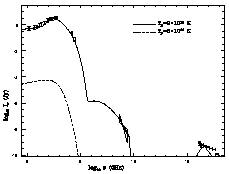
Blazars in Low-Luminosity and Radio-Weak AGN?
Heino Falcke, Sera Markoff, & Peter L. Biermann
Max-Planck-Institut für Radioastronomie, Auf den Hügel 69, D-53121 Bonn, Germany (hfalcke,smarkoff@mpifr-bonn.mpg.de)in "Blazar Demographics and Physics", ASP Conf. Ser. Vol. 227, Eds. P. Padovani & M.C. Urry, p. 56
Abstract:
Typical blazars seem to be associated with FR I and FR II radio galaxies and radio-loud quasars. However, what happens at lower powers? Do blazars exist in low-luminosity AGN or do they exist in radio-quiet AGN? Our recent detection of superluminal motion in a supposedly radio-quiet Seyfert raises the question whether beaming can play an important role in some of these objects as well. Moreover, VLBI observations of nearby low-luminosity AGN reveal compact flat-spectrum radio cores very similar to those in bright radio-loud blazars. Furthermore, with the detection of X-ray emission from the least luminous AGN we can study, Sgr A* in the Galactic Center, this source seems to be dominated entirely by non-thermal emission -- like in BL Lacs. The same may be true for some X-ray binaries in the Low/Hard-state. Inclusion of low-power radio jets into the overall picture provides some clues for what type of accretion is important, what the power, radiative efficiency and matter-content of jets is, and what mechanism could be responsible for making jets radio-loud. We specifically discuss whether proton-proton collisions in a hot accretion flow could provide the switch for the radio-dichotomy.
Paper: Available in PostScript and (AAS)LaTex. Please send an email request to hfalcke@mpifr-bonn.mpg.de for a preprint.
Other publications can be found here.
Questions: Heino Falcke, hfalcke@mpifr-bonn.mpg.de